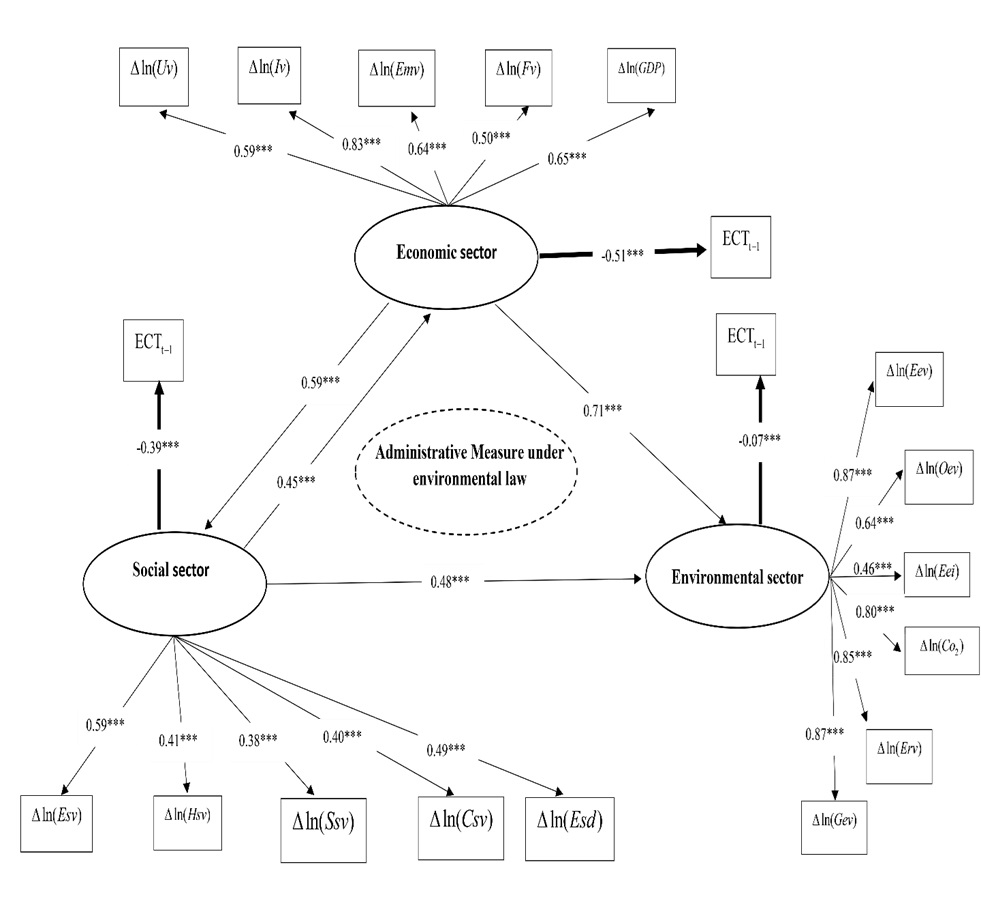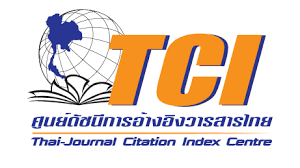A New Scenario Management Model in the Establishment of Administrative Measures
Keywords:
Administrative measure, environmental law, sustainability, mixed methods research, protection measuresAbstract
This research aimed to study the magnitude of the impact resulting from changes in the factors of the future scenario policy under Thailand's sustainability policy for the upcoming two decades, spanning from 2020 to 2039 by developing a best linear unbiased estimator (BLUE) model. The model was named structural equation modeling based on autoregressive integrated moving average with observed variables at first difference (SEM-var(1)). The central gap between this model and other model was the applicability of the proposed model for effective medium-term forecasting without spuriousity. As for the findings, the latent variables of the three sectors were causally found upon using the SEM-var(1) model with the highest performance, with a mean absolute percentage error (MAPE) of 1.50 percent and a root mean square error (RMSE) of 1.75 percent. Furthermore, the new scenario policy was established by requiring at least 20 percent green technology and keeping future total energy consumption (2020-2029) below the country's carrying capacity. As a result, the future CO2 emission growth rate (2020-2029) would be 7.05 percent (2020-2029) or 39.01 Mt CO2Eq (from 2020-2029), which was less than the carrying capacity set by not exceeding 65.04 Mt CO2Eq (from 2020-2029). As for the administrative measures, Thailand must operate administrative legislation measures within environmental law by considering three key elements: 1) Principles of Environmental Protection Measures Planning, 2) Principles of Environment Damage Management, and 3) Principle of Polluters Pays. This result further indicated that the model is best suited for application in the formulation of future national administration plans.
References
The World Bank: Energy Use (Kg of Oil Equivalent Per Capita) Home Page. December 2023, Available: https://data.worldbank.org/indicator/EG.USE.PCAP.KG.OE.
Office of the National Economic and Social Development Council (NESDB). December 2023, Available: http://www.nesdb.go.th/nesdb_en/more_news.php?cid=154&filename=index.
National Statistic Office Ministry of Information and Communication Technology. December 2023, Available: http://web.nso.go.th/index.htm.
Department of Alternative Energy Development and Efficiency. December 2023, Available: http://www.dede.go.th/ewtadmin/ewt/dede_web/ewt_news.php?nid=47140.
P. Sutthichaimethee, “Forecasting Economic, Social and Environmental Growth in the Sanitary and Service Sector Based on Thailand’s Sustainable Development Policy,” Journal of Ecological Engineering, vol.19, no. 1, pp. 205-210, 2018.
United Nations Framework Convention on Climate Change, UNFCCC, Bonn, Germany. “Global Progress in Environmental Law,” Environmental Policy and Law, vol.46, no. 1, pp. 23-27, 2016.
United Nations, The World Population in 2014, New York, 2014.
United Nations. University of Oslo. (2015). Walter Wallace Wheel. December 2023, Available: http://www.uio.no/studier/emner/matnat/ifi/INF5180/v10/undervisningsmateriale/handout s/09_WWHEEL315.pdf.
Pollution Control Department Ministry of Natural Resources and Environment. Enhancement and Conservation of National Environmental Quality Act, B.E. 2535. December 2023, Available: http://www. pcd. go. th/ info_serv/reg_envi.html.
K. Grecksch and C. Klöck, “Access and allocation in climate change adaptation,” Int Environ Agreements., vol.20, pp.271–286, 2020.
J. Gupta and L. Lebel, “Access and allocation in earth system governance: water and climate change compared,” Int Environ Agreements, vol.10, pp.377–395, 2010.
D. Gonenc1, D. Piselli and Y. Sun, “The global economic system and access and allocation in earth system governance,” Int Environ Agreements, vol.20, pp.223–238, 2020.
J. Gupta and L. Lebel, “Access and allocation in earth system governance: lessons learnt in the context of the Sustainable Development Goals,” Int Environ Agreements, vol. 20, pp. 393–410, 2020.
J. Gupta and K. Tienhaara, “Investment for sustainable development: panacea, placebo or problematic,” Int Environ Agreements, vol.6, pp.323–327, 2006.
J. Gupta, and C. Vegelin, Sustainable development goals and inclusive development. Int Environ Agreements, 16, 433–448., 2016
J. Fernandez, “Environmental implications of trade liberalization on North American transport services: the case of the trucking sector,” Int Environ Agreements, vol.10, pp.133–145, 2010.
I.A. Quesada and H.P. “Weikard, International Environmental Agreements for biodiversity conservation: a game-theoretic analysis,” Int Environ Agreements, vol. 17, pp. 731–754, 2017
N. Busscher, C. Parra and F. Vanclay, “Environmental justice implications of land grabbing for industrial agriculture and forestry in Argentina,” Journal of Environmental Planning and Management, vol.63, no. 3, pp.500–522, 2020, Available: https://doi.org/10.1080/09640568.2019.1595546
K. Dooley and A. Gupta, “Governing by expertise: the contested politics of (accounting for) land-based mitigation in a new climate agreement,” Int Environ Agreements, vol.17, pp. 483–500. 2017.
B. Sandler, “Grow or Die: Marxist Theories of Capitalism and the Environment,” Rethinking Marxism, vol.7, no.2, pp.38-57, 1994.
D.E. van. Norren, “The Sustainable Development Goals viewed through Gross National Happiness, Ubuntu, and Buen Vivir,” Int Environ Agreements, vol.20, pp.431–458, 2020.
C.A. Sénit, “Transforming our world? Discursive representation in the negotiations on the Sustainable Development Goals,” Int Environ Agreements, vol.20, pp.411–429, 2020.
T.S. Faran, “Lennart Olsson1 Geoengineering: neither economical, nor ethical—a risk–reward nexus analysis of carbon dioxide removal,” Int Environ Agreements, vol.18, pp.63–77, 2018.
W. Bardi, S.E. Ayouni, and M. Hamdaoui, “Are structural policies in countries bordering mediterranean appropriate to economic convergence: Panel ARDL Application,” Cogent Economics & Finance, vol.7, no.1, pp. 2-20, 2019.
V. Mykhnenko, and M. Wolff, “State rescaling and economic convergence,” Regional Studies, vol.53, no.4, pp.462-477, 2019.
A.M. Bocse1, “Hybrid transnational advocacy networks in environmental protection: banning the use of cyanide in European gold mining,” Int Environ Agreement, 2020, Available : https://doi.org/10.1007/s10784-020-09492-6.
Y. Shen1, and M. Faure, “Green building in China,” Int Environ Agreements, 2020, Available https://doi.org/10.1007/s10784-020-09495-3.
S. Switzer, L. Gerber, and F. Sindico, “Access to Minerals: WTO Export Restrictions and Climate Change Considerations,” Laws, vol.4, pp.617–637, 2015.
J. Handrlica and V. Sancin, “Earthquakes in nuclear liability conventions: a study in international disaster law,” Journal of Energy & Natural Resources Law, 2020.
A. Gupta, T. Pistorius, and M.J. Vijge, “Managing fragmentation in global environmental governance: the REDD+ Partnership as bridge organization,” Int Environ Agreements, vol.16, pp. 355–374, 2016.
D.A. Dickey, and W.A. Fuller, “Likelihood ratio statistics for autoregressive time series with a unit root,” Econometrica, vol.49, pp. 1057–1072, 1981.
S. Johansen and K. Juselius, “Maximum likelihood estimation and inference on cointegration with applications to the demand for money,” Oxford Bulletin of Economics and Statistics, vol.52, pp.169–210, 1990.
S. Johansen, Likelihood-Based Inference in Cointegrated Vector Autoregressive Models. New York: Oxford University Press, 1995
W. Enders, “Applied Econometrics Time Series; Wiley Series in Probability and Statistics, Tuscaloosa: University of Alabama, 2010.
A.C. Harvey, “Forecasting, Structural Time Series Models and the Kalman Filter,” Cambridge: Cambridge University Press, 1989.
C. A. Sims, “Macroeconomics and Reality,” Econometrica, vol.48, pp.1–48, 1980.
B.M. Byrne, “Structural Equation Modeling with AMOS: Basic Concepts, Applications, and Programming,” London: Routledge, 2009.
P. Sutthichaimethee, “Model of Environmental Problems Priority Arising from the Use of Environmental and Natural Resources in Machinery Sectors of Thailand,” in Environmental and Climate Technologies, vol.17, no. 1, pp.18–29, 2016.
P. Sutthichaimethee, “Varimax Model to Forecast the Emission of Carbon Dioxide from Energy Consumption in Rubber and Petroleum Industries Sectors in Thailand,” Journal of Ecological Engineering, vol.18, no.3, pp.112–117. 2017.
P. Sutthichaimethee, and B. Dockthaisong, “A Relationship of Causal Factors in the Economic, Social, and Environmental Aspects Affecting the Implementation of Sustainability Policy in Thailand: Enriching the Path Analysis Based on a GMM Model,” Resources, vol.7, no.4, pp.87.
P. Sutthichaimethee, and D. Ariyasajjakorn, “Forecasting Model of GHG Emission in Manufacturing Sectors of Thailand,” Journal of Ecological Engineering, vol.18, no.1, 18–24, 2018.
P. Sutthichaimethee and D. Ariyasajjakorn, “Forecast of Carbon Dioxide Emissions from Energy Consumption in Industry Sectors in Thailand,” Environmental and Climate Technologies, vol.22, no.1, pp.107–117, 2018.
P. Sutthichaimethee and K. Kubaha, “A Relational Analysis Model of the Causal Factors Influencing CO2 in Thailand’s Industrial Sector under a Sustainability Policy Adapting the VARIMAX-ECM Model,” Energies, vol.11, no.7, 1704, 2018.
P. Sutthichaimethee, and D. Ariyasajjakorn, “A Forecasting Model on Carrying Capacity for Government’s Controlling Measure under Environmental Law in Thailand: Adapting Non-recursive Autoregression Based on the Var-X Model,” International Journal of Energy Economics and Policy, vol.10, no.6, pp.645-655, 2018.
P. Sutthichaimethee and D. Ariyasajjakorn, “The revised input-output table to determine total energy content and total greenhouse gas emission factors in Thailand,” Journal of Ecological Engineering, vol.18, no.6, pp.166–170, 2017.
P. Sutthichaimethee and K. Kubaha, “The Efficiency of Long-Term Forecasting Model on Final Energy Consumption in Thailand’s Petroleum Industries Sector: Enriching the LT-ARIMAXS Model under a Sustainability Policy,” Energies, vol.11, no.8, pp. 2063, 2018.

Downloads
Published
How to Cite
Issue
Section
License

This work is licensed under a Creative Commons Attribution-NonCommercial-NoDerivatives 4.0 International License.








